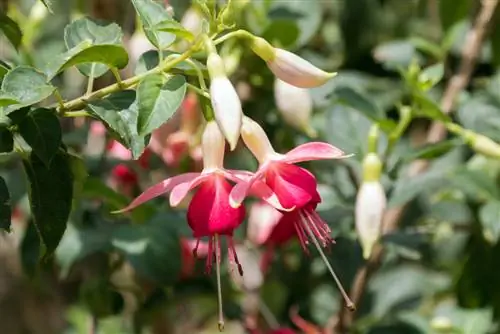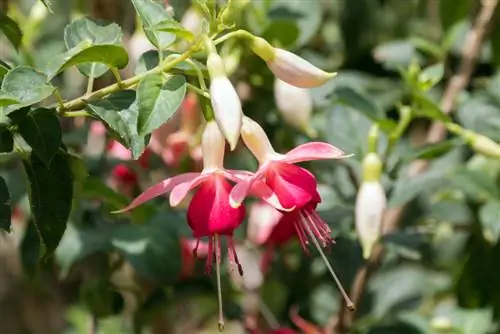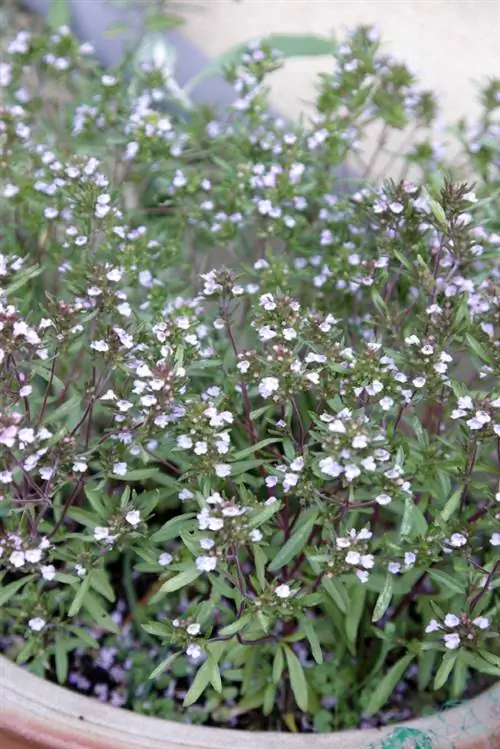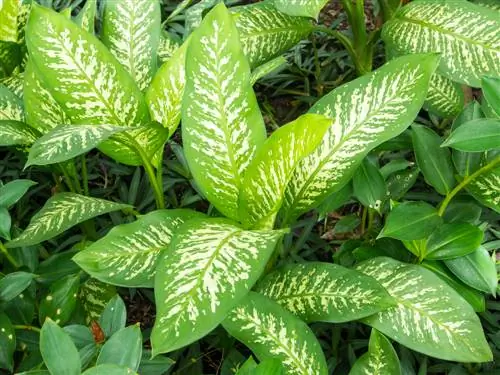- Author admin [email protected].
- Public 2023-12-25 17:45.
- Last modified 2025-06-01 06:02.
Since their introduction to Europe in the 19th century, fuchsias have fascinated hobby gardeners and breeders alike. The pretty, uniquely structured flowers of these plants are an eye-catcher in garden beds and balcony boxes. Contrary to popular belief, woody shrubs are perennial species, but are generally not hardy and must therefore be kept frost-free over the winter. With the right care, you can enjoy the lush flowers for many years.

What should you know about caring for fuchsias?
Fuchsias are attractive, perennial flowering plants that come in approximately 100 species and 12,000 varieties. They prefer bright, but not directly sunny locations and require frost-free overwintering. The lush flowers in different colors appear from May until the first frost.
Origin and distribution
Fuchsias (Fuchsia) are, with around 100 species and around 12,000 varieties, a very species- and varied genus within the evening primrose family (Onagraceae). Many of the wild species come from the forests of the Andes in Central and South America, but are now widespread on both American continents and through garden refugees in climatically favorable regions of Europe. A few fuchsia species - such as the tree-like Fuchsia excorticata or the dwarf form Fuchsia procumbens, which we often cultivate in rock gardens - are native to New Zealand and only one species to Tahiti in the South Pacific.
The Cape fuchsias (Phygelius capensis and Phygelius aequalis), which are externally quite similar and are native to South Africa, belong to the figwort family and are not related to the genus Fuchsia. Cape fuchsias are pretty but still quite rare pot and bed plants that, in contrast to real fuchsias, require a sunny and dry location.
Usage
In Central Europe, fuchsias are mainly cultivated as balcony and container plants due to their lack of winter hardiness. They are mainly interesting for planting on terraces and balconies in shaded areas because they thrive primarily in bright, but not directly sunny and rather cool locations. Fuchsias are also one of the species that bloom particularly profusely in rainy summers - high humidity and temperatures between 16 and 24 °C provide perfect growing conditions for the flowering plants.
If you want to combine fuchsias with other flowering plants in a border, you can bury the bush and its pot in the ground. In autumn, simply lift the plants out again and leave them over the winter in a frost-free and bright place. However, most species and varieties are not suitable for indoor cultivation in living rooms that are heated all year round, as the humidity here is far too low. The plants are particularly uncomfortable with a location directly on the window sill and above a heater.
If you want to keep fuchsias as houseplants, you should place the plants in a very bright place, but not in direct sunlight. Ensure there is sufficient moisture by placing the pots in a bowl of water - be careful, the roots must not be left permanently wet! - and spray the plants with a sprayer every two to three days.
Appearance and growth
Fuchsias are a very diverse genus, with most of the varieties we cultivate growing as woody shrubs up to about half a meter to a meter high. There are also low forms such as Fuchsia procumbens, which is also known as creeping fuchsia and only grows to around five centimeters high. Other species such as the New Zealand tree fuchsia - of which you can sometimes buy seeds for hobby cultivation in specialist shops -, on the other hand, grow as small trees and reach heights of up to ten meters in their natural environment. Shrub or semi-shrub-like growth forms are often also suitable for growing on a trellis.
Fuchsias can also be grown as half or standard stems and as bonsai.
leaves
The green fuchsia leaves are typically elliptical in shape, sit on long stems and have a slightly serrated edge. As a rule, the leaves remain on the plant during the winter months and are only shed in dark overwintering locations.
Bloom and flowering time
The most striking feature of the fuchsias, however, are their often two-colored bell flowers, which sit on flower stalks up to eight centimeters long. The flowers, which are usually quite large, consist of an ovary followed by a tube orthe calyx tube (hypanthium) and the four sepals attached to it, from which the four to seven corolla petals protrude. The style also protrudes far from the corolla, while the sepals are typically slightly bent back.
Sepals and petals have different colors in most varieties, with the color spectrum including an extensive range of reds, pinks, purples and even blues as well as white.
With good care and a sufficiently bright location, fuchsias bloom for a very long time: the first flowers appear in May or June, then the plant tirelessly produces new ones until the first frost.
Fruits
Small berries develop from the flowers, which are black when ripe. These are not edible raw, but can be made into an unusual jam. In Great Britain, where fuchsias thrive in the typical southern English climate, fuchsia jam is a popular delicacy.
However, the ripe berries often contain enough seeds to grow fuchsias yourself. However, the grains are only germinable for a short time and should therefore be planted as quickly as possible.
Is fuchsia poisonous?
Fuchsias are not poisonous, but - when consumed in large quantities - can cause stomach and intestinal problems such as nausea and diarrhea. In such a case, it is advisable to drink plenty of water and possibly swallow activated charcoal. Both the ripe berries and the flowers are considered edible.read more
Which location is suitable?
Most fuchsias prefer a bright, but not full sun and rather cool location. In partially shady and sunny areas - not directly shady! - Places the plants therefore feel most comfortable. However, there are also some varieties that cope well with the sun and can therefore be planted well in sunny locations. These include the Triphylla hybrids, which are also known as grape-flowered fuchsias. How sun-tolerant individual plants are depends not only on genetics. Basically, high humidity and a sufficient supply of water and fertilizer help the flowering plants feel comfortable even in sunny places.
However, make sure that the planters and therefore the roots of sunny fuchsias do not heat up. To do this, shade the containers or cover the root area of planted specimens, which can be done by mulching with bark mulch or underplanting with ground-covering perennials such as ivy, Waldsteinia, fat man or small evergreen.
Floor
Fuchsias prefer loose, well-drained, fresh and humus-rich soil. Use nutrient-rich compost for potted plants.
pot culture
Since most fuchsia species and varieties are not hardy, pot culture is recommended. If possible, choose planters made of natural materials such as clay, as these do not heat up as quickly as containers made of plastic or even metal. The root balls of these plants cannot tolerate heat and should therefore remain as cool as possible. Clay that “breathes” and therefore naturally heats up less is particularly suitable. Fuchsias can also be kept in balcony boxes as long as they have good drainage. You can plant between five and seven fuchsias in such a box, which is about one meter long. In hanging baskets, however, the hanging varieties are particularly effective.
Planting fuchsias correctly
However, there are also some hardy varieties that can be planted in flower beds or in perennial borders. You can plant varieties such as 'Beacon Rosa', 'Caledonia' or 'Delicate Purple', but you must always provide them with light winter protection - such as a cover with spruce or fir branches. In addition, the above-ground parts of the plant freeze back when there is frost and therefore have to be cut off in spring. The plants usually sprout again from the roots the following spring.
However, this does not apply to fuchsias cultivated in planters, even if the variety is declared winter-hardy. Due to the small amount of soil in the pot, the roots also freeze, which can usually be prevented by covering them with garden fleece or similar winter protection.
Even tall stems should always overwinter frost-free, as they freeze back to the ground - and of course the trunk shape is lost.read more
What is the best time to plant?
Plant hardy fuchsias in the bed between June and July, whereas potted plants go on the balcony or terrace after the last late frosts - i.e. from the end of May. The plants stay there until September/October, but should definitely be brought back indoors before the first frost. One or two frosty nights cause the above-ground parts of the plant to freeze back, but the plant can still survive temperatures below 0 °C for a short time.
Watering fuchsias
Fuchsias kept in pots are only watered when the substrate has dried out a little. Avoid watering root balls that are still wet, as this leads to waterlogging and causes the plants to die. If it is dry and hot, spray specimens standing outside using a spray bottle, because when the humidity is low, the plant sheds leaves and flowers prematurely.
You should also not be fooled by drooping leaves in hot temperatures: fuchsias tend to do this to protect themselves from excessive evaporation. However, additional watering is not necessary as long as the root ball is still moist. The leaves will straighten up again as soon as the heat subsides.
If possible, water with lukewarm rainwater or well-stagnant tap water, but this should not be cold either.
Fertilize fuchsias properly
Between March and August you should fertilize fuchsias regularly, for which a liquid fertilizer is best suited. Administer this every one to two weeks together with the irrigation water, but never fertilize on dry substrate or in high heat.read more
Cut fuchsias correctly
In order to be able to enjoy the abundance of flowers for as long as possible, you should regularly - i.e. H. once a week - clean out. Do not remove the flowers, but especially the ovaries. Otherwise, berries will form instead of new flowers.
Winter-hardy fuchsias are also cut down by about a third in autumn. In spring, remove all frozen plant parts and provide the plants with booster fertilization. Even non-hardy specimens that overwinter frost-free should be cut back before putting them away for winter quarters, otherwise they will become too woody and no longer grow as densely.
Propagate fuchsias
It is very easy to propagate fuchsias using top cuttings, for which you cut off soft and flowerless shoots that are about ten centimeters long in July. Place them in a nutrient-poor growing substrate and keep it evenly warm at around 20 °C - then the shoots will root particularly quickly. It is also important to keep the substrate slightly moist at all times. Growing in a greenhouse or similar is not necessary, and rooting in a glass of water is essentially an unnecessary step. As soon as the young plants develop new leaves, the roots are strong enough to be transplanted into nutrient-rich compost soil.
You can get seeds from the ripe berries, but you should carefully remove the surrounding pulp and rinse them under running water. Then sow them immediately and cover the grains with soil - fuchsias are dark germinators. As with propagating cuttings, the substrate should be kept warm and moist.read more
Wintering
Fuchsias that are not hardy are best overwintered brightly and frost-free at five to a maximum of ten degrees Celsius. Do not fertilize the plants during this time and water sparingly. Hardy, planted specimens, on the other hand, receive light winter protection, for example in the form of a cover with spruce or fir branches.
How do I transplant correctly?
Fuchsias cultivated in pots are repotted into fresh substrate every spring, whereby the planter should only be slightly larger than the root ball. Otherwise, the plants will only develop loose roots that will not give them enough support in the pot.
Diseases and pests
Fuchsias react quite sensitively to unsuitable locations and care errors. Waterlogging, root rot and diseases caused by fungi such as fuchsia rot, powdery mildew, downy mildew and gray mold (Botrytis) occur frequently. Whiteflies, spider mites and aphids are particularly common pests, and the black weevil can also be found in planted specimens.
Fuchsia doesn't bloom, what to do?
If fuchsias don't want to bloom, it's often too dark where they are. The plants need light to form flowers, which is why they are particularly lush in sunny places with sufficient care. Furthermore, a nutrient deficiency also leads to lazy flowering, because fuchsias have a high nutrient requirement.
Tip
Sticky leaves are not a sign of pest or disease infestation, but are due to the very nectar-rich flowers. When grown outdoors, this layer is washed away by the rain; when grown indoors, you have to wipe the leaves off by hand.
Species and varieties
The most beautiful species and varieties for pots and gardens are not easy to choose from the wide variety. We have nevertheless put together a few recommended fuchsias for you.
Fuchsia magellanica
The species, also known as scarlet fuchsia, grows to around one to one and a half meters high and is striking for its slender, colorful flowers. Scarlet fuchsias are generally hardy. Beautiful varieties include:
- ‘Alba’: two-tone white and light pink flowers, upright growth
- ‘Alice Hoffmann’: red and white flowers, low growth
- 'Lady Thumb': red and purple flowers, dwarf form
- ‘Tricolor’: red and blue flowers, upright growth
Fuchsia triphylla
The coral fuchsia has strikingly long, slender inflorescences. The species is not hardy. The following varieties are well suited for keeping in pots on balconies and terraces:
- 'Gartenmeister Bonstedt': red and orange flowers, upright, very branched growth
- 'Leverkusen': two-tone pink flowers, upright and low growth
- 'Mary': pretty dark red flowers, upright and low growth
Other fuchsia species
In addition to those mentioned, other species - such as Fuchsia paniculata or the ground-covering Fuchsia procumbens - can be cultivated both in the garden and in pots. In addition, there are now many winter-hardy new varieties that can easily be cared for when planted out in the garden.






